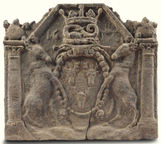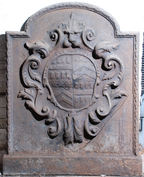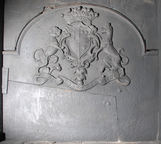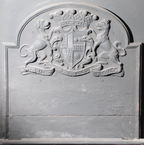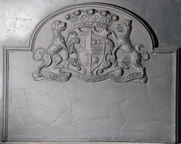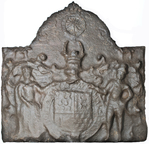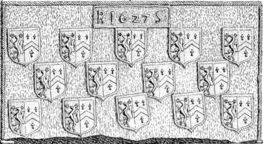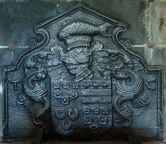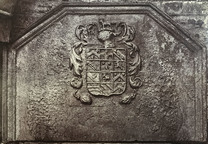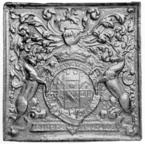-
246
Description: Quasi-arched rectangular shape; on a ground, an armorial achievement comprising a central cartouche on which is an oval shield bearing the arms of the Cavendish family, with graduated bead edging; supporters, two stags rampant; above the cartouche, on a wreath a coiled snake crest surmounted by an earl’s coronet; the date split either side of the crest; to each side, a column with foliate capital supporting a three-sided arch with ovolo-moulded edging, on each shoulder of which is a flaming orb.
Notes: The arms are those of William Cavendish, 3rd Earl of Devonshire (1617-84). Sotheby's auction, The Chatsworth Attic Sale, 7 Oct 2010, lot 3 (£18,750).
Inscription: 1657
Arms: William Cavendish, 3rd Earl of Devonshire
- Decoration tags:
- rectangular with three-facetted arch (shape)
- complex individual (edging)
- whole carved pattern
- individual numbers
- armorial
- text
Manufactured: in 1657 in England.
Current location: not known.
- Attached to series:
- Personal armorial firebacks
- Cavendish arms series
-
34
Description: Arched rectangular shape; astragal and fillet edging (top and sides) with overlapping leaf pattern; floral cartouche with lion’s face at top, enclosing a shield bearing the arms of May (Gules, a fess between eight billets Or) quartering Broadnax (Or, two chevrons gules, on a chief of the last three cinquefoils Argent); at base a plain cuboid plinth.
Notes: Thomas Broadnax (1701-81), son of William Broadnax of Godmersham, Kent, and Anne May, heiress of Christopher May, inherited the estate of his cousin, Sir Thomas May, adopting his surname in 1727. He later changed his name to Knight on inheriting the estate of that family at Chawton in 1738.
Arms: May quartering Broadnax
- Decoration tags:
- rectangular with round arch (shape)
- astragal & fillet (edging)
- carved pattern panels
- armorial
Manufactured: in the early-18th century possibly in the Weald area of England.
Current location: Chawton House, Chawton, Hampshire, England.
- Attached to series:
- Personal armorial firebacks
-
248
Description: Arched rectangular shape; astragal and fillet edging; shield, motto, earl’s coronet and supporters (a talbot erm. and a wolf or, ducally crowned gu.) of Stanhope impaling Pitt: quarterly (1st & 4th) erm. (2nd & 3rd) gu. (Stanhope); sa., a fess chequy az. and ar. between three bezants (Pitt); motto: A DEO ET REGE.
Notes: James Stanhope was created 1st Earl in 1718; he had married Lucy Pitt in 1714. The Stanhope seat was Chevening, near Sevenoaks.
Inscription: A DEO ET REGE
Arms: Stanhope impaling Pitt; James, Ist Earl Stanhope
- Decoration tags:
- rectangular with round arch (shape)
- astragal & fillet (edging)
- carved pattern panels
- armorial
- text
Manufactured: in the early-18th century in England.
Current location: Chevening Park, Chevening, Kent, England.
- Attached to series:
- Personal armorial firebacks
- Stanhope series
-
249
Description: Arched rectangular shape; astragal and fillet edging; shield, motto, earl’s coronet and supporters (a talbot erm. and a wolf or, ducally crowned gu.) of Stanhope impaling Pitt: quarterly (1st & 4th) erm. (2nd & 3rd) gu. (Stanhope); sa., a fess chequy az. and ar. between three bezants (Pitt); motto: A DEO ET REGE.
Notes: James Stanhope was created 1st Earl in 1718; he had married Lucy Pitt in 1714. The Stanhope seat was Chevening, near Sevenoaks.
Inscription: A DEO ET REGE
Arms: Stanhope impaling Pitt; James, 1st Earl Stanhope
- Decoration tags:
- rectangular with round arch (shape)
- astragal & fillet (edging)
- carved pattern panels
- armorial
Manufactured: in the early-18th century in England.
Current location: Chevening Park, Chevening, Kent, England.
- Attached to series:
- Personal armorial firebacks
- Stanhope series
-
250
Description: Arched rectangular shape; astragal and fillet edging; shield, motto, earl’s coronet and supporters (a talbot erm. and a wolf or, ducally crowned gu.) of Stanhope impaling Pitt: quarterly (1st & 4th) erm. (2nd & 3rd) gu. (Stanhope); sa., a fess chequy az. and ar. between three bezants (Pitt); motto: A DEO ET REGE.
Notes: James Stanhope was created 1st Earl in 1718; he had married Lucy Pitt in 1714. The Stanhope seat was Chevening, near Sevenoaks.
Inscription: A DEO ET REGE
Arms: Stanhope impaling Pitt; James, 1st Earl Stanhope
- Decoration tags:
- rectangular with round arch (shape)
- astragal & fillet (edging)
- carved pattern panels
- armorial
- text
Manufactured: in the early-18th century in England.
Current location: Chevening Park, Chevening, Kent, England.
- Attached to series:
- Personal armorial firebacks
- Stanhope series
-
1259
Description: Plain rectangular plate; shield, garter, helm, mantling and supporters of the Blount family, Lords Mountjoy; above, a Garter enclosing a sun charged with an eye, all surmounted by an earl's coronet; decorative edging of the arch in low relief.
Notes: The arms are those of Charles Blount, 8th Baron Mountjoy (1563-1606), who was invested Knight of the Garter in 1597. He was created 1st Earl of Devonshire in 1603 and the original fireback, of which this is probably a copy, therefore dates from between 1603 and 1606. Blazon: 1. (Blount) Barry nebuly of six Or and Sable; 2. (Ayala) Argent, two wolves passant Sable on a bordure of the first eight saltires Gules; 3. (Mountjoy) Or a tower Azure; 4. (Gresley) Vair. The fireback was made by taking a worn casting of the Mountjoy arms (for a clearer example see no. 740) and using it as a pattern, adding an extension above with the decorative edging and the crowned Garter and sun, the detail of which is sharper than the armorial below. The Garter and sun as a badge of Charles Blount has been noted on two contemporary book bindings. The fireback may have come from Dedisham Manor in West Sussex, which belonged to a cadet branch of the Blount family from 1545 to 1636 and which, in the latter year, was sold to Richard Onslow who later built Clandon Park.
Inscription: Garter motto [mostly illegible]
Arms: Charles Blount, KG, 8th Baron Mountjoy, Earl of Devonshire
- Decoration tags:
- rectangular with round arch (shape)
- none (edging)
- carved stamps
- whole carved pattern
- heraldic
- armorial
Manufactured: in the early-17th century possibly at Dedisham Furnace, Rudgwick in the Weald area of England.
Current location: Clandon Park, West Clandon, Surrey, England.
Museum number: 1441937 (part of the National Trust museum group)
- Attached to series:
- Personal armorial firebacks
- Mountjoy series
-
1007
Description: Rectangular; twisted rope edging on top and sides; cavetto-moulded-edged rectangle top centre, enclosing date between initials; 14 shields of Ayloffe impaling Sulyard arranged 5-4-5; Ayloffe: sable, a lion rampant Or, collared gules, between three crosses formy of the second; Sulyard: argent, a chevron gules between three pheons inverted sable.
Notes: William Ayloffe (c1535-1584) of Bretons, Hornchurch, Essex, Justice of the Court of Queen's Bench, married (c1560) Jane, dau. of Sir Eustace Sulyard, of Runwell, Essex. A large number of variants use the same shields; this example, unusually, has the initials RS instead of the more common CT. Illustration from Cowper (1911). Previously at Loddenden, Staplehurst, and before that at Great Cheveney, Marden, Kent.
Inscription: R 1627 S
Arms: Ayloffe impaling Sulyard (William Ayloffe of Bretons, Hornchurch)
- Decoration tags:
- rectangular (shape)
- rope (edging)
- carved stamps
- individual letters
- individual numbers
- armorial
- text
Manufactured: in 1627 possibly at Hawkhurst Furnace in the Weald area of England.
Current location: not known.
- Attached to series:
- Ayloffe series
- Personal armorial firebacks
-
857
Description: Rectangular with detached pediment linked by S-curves, protruding from each of which is a small scroll; cavetto-moulded edging (top and sides); quartered shield with helm, crest and mantling; initials in top corners.
Notes: The arms are of Sir Julius Caesar (1558-1636), judge and politician, Chancellor of the Exchequer 1606-13. Blazon: Quarterly, 1st and 4th, Gules, three roses argent, on a chief of the second three roses of the first (Caesar); 2nd, argent, two bars sable, on a chief of the second three swans of the first (?Martin); 3rd, gules, three crescents argent (Peryent/Perin). Crest: a dolphin embowed in the sea vert. This example has the additional initials, TC. The style of the carving is the same as on two other firebacks in the same county.
Copies of this fireback are known.
Inscription: T C
Arms: Caesar
- Decoration tags:
- rectangular with detached pediment (shape)
- cavetto (edging)
- whole carved pattern
- individual letters
- planklines
- armorial
- text
Manufactured: in the early-17th century possibly in the Herefordshire area of England.
Current location: Croft Castle, Yarpole, Herefordshire, England.
Museum number: 537532 (part of the National Trust museum group)
- Attached to series:
- Personal armorial firebacks
- Loop edged firebacks
- Herefordshire armorial series
-
335
Description: Canted rectangle; stepped edging; unidentified shield with 12 quarterings, helm and crest; arms carved on rectangular back board.
Notes: Two horizontal plank lines; arms over-stamped. Photographed at Messrs. C. Pannett & Sons, Highgate, Hawkhurst, Kent; from an album of photographs of firebacks by W. Galsworthy Davie c.1912 (National Art Library, Victoria and Albert Museum, London).
Copies of this fireback are known.
Arms: Not known
- Decoration tags:
- rectangular with canted top corners (shape)
- rebated fillet (edging)
- carved pattern panels
- planklines
- armorial
Manufactured: in the late-16th to early-17th century possibly in the Weald area of England.
Current location: not known.
Citation: Shuffrey, L. A., 1912, The English Fireplace, London, Batsford.
- Attached to series:
- Personal armorial firebacks
-
268
Description: Rectangular; cavetto moulded edging; shield, garter, coronet, helm, crest, supporters and motto of Villiers, 1st Duke of Buckingham.
Notes: The arms are those of George Villiers (1592-1628), created Duke of Buckingham in 1623. Blazon: Quarterly 1, Villiers (modern) - argent, on a cross gules five scallops or; 2, Villiers (ancient) - sable, a fess between three cinquefoils argent; 3, Pakeman - gules, a chevron between three crosses botonnee fitchee argent; 4, Bellers - per pale gules and sable, a lion rampant argent crowned or; 5, Hoby - azure, a bend between six mullets argent; 6, Kirkby - argent, a cross between two annulets vert.
Copies of this fireback are known.
Inscription: HONI SOIT QVY MAL Y PENSE / FIDEI COTICULA CRUX [The cross is the touchstone of faith]
Arms: George Villiers, 1st Duke of Buckingham
- Decoration tags:
- rectangular (shape)
- cavetto (edging)
- whole carved pattern
- planklines
- armorial
Manufactured: in the early-17th century in England.
Current location: not known.
Citation: Dawson, C., 1903, 'Sussex Iron Work and Pottery', Sussex Archaeological Collections, 46, pp. 1-54.
- Attached to series:
- Personal armorial firebacks
- Bristol armorial group
